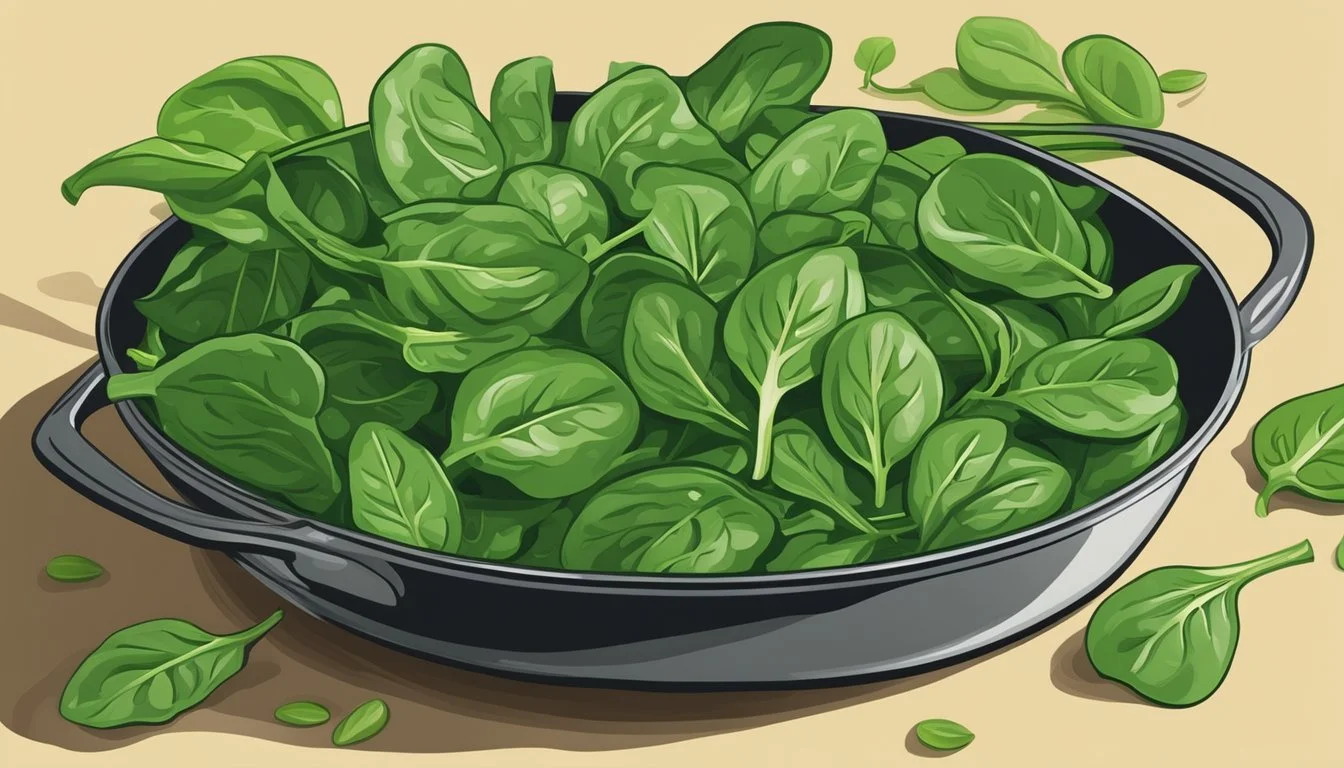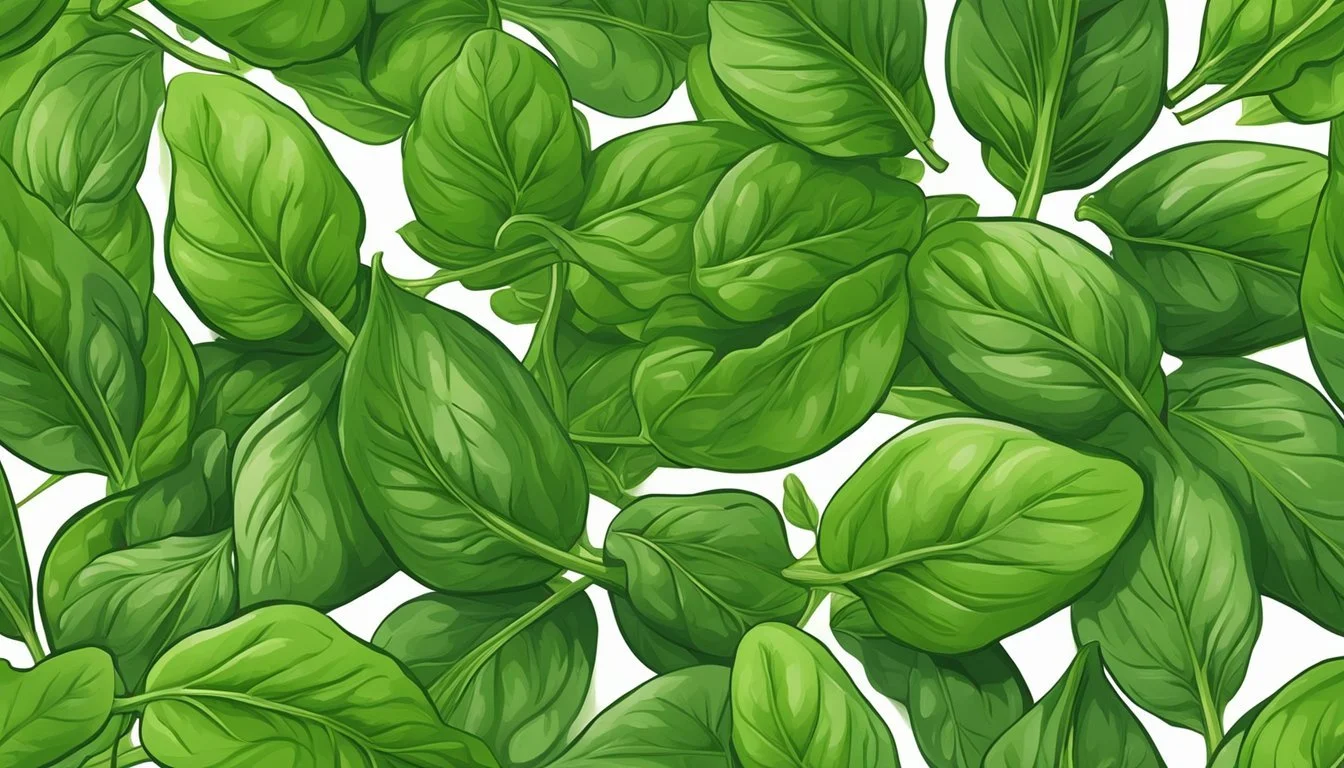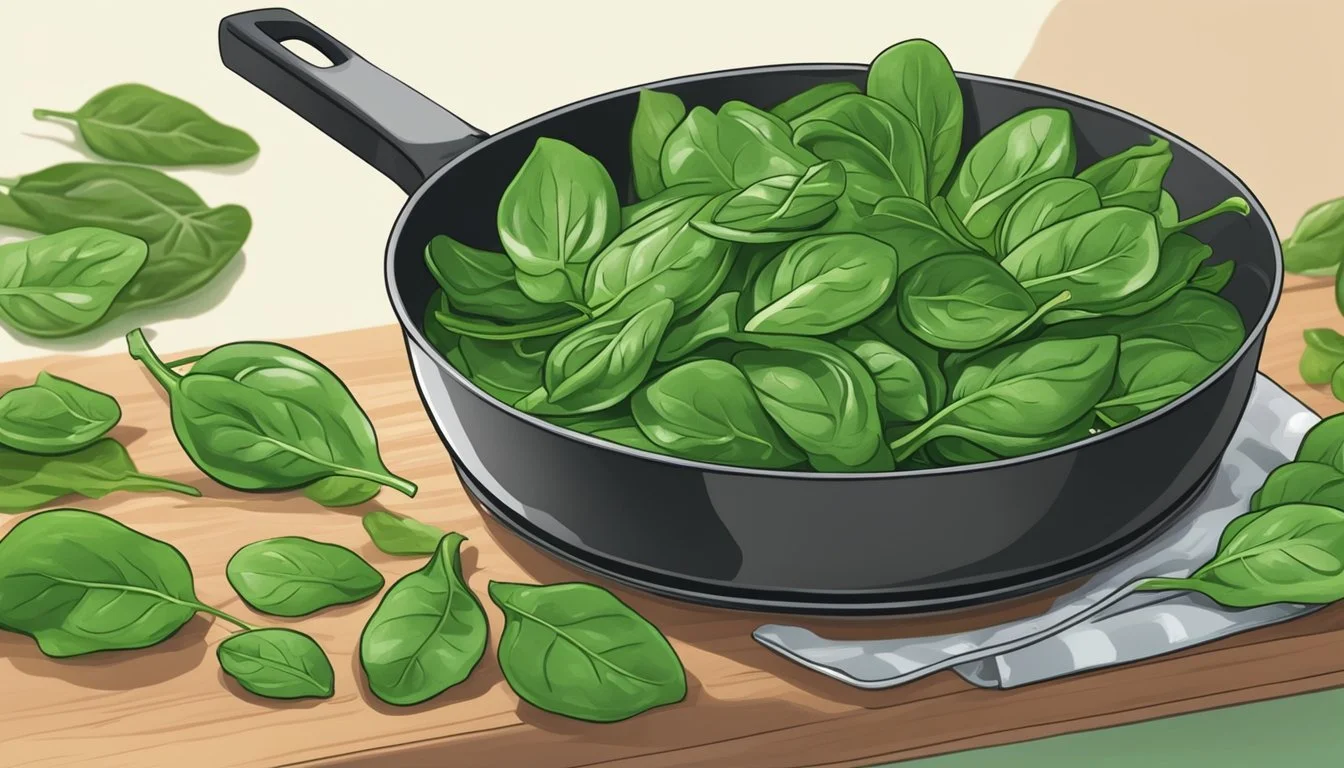Reviving Limp Spinach
How to Refresh Your Greens for Perfect Salads and Sautés
Reviving limp spinach (What wine goes well with spinach?) is an uncomplicated process that transforms less-than-crisp leaves into vibrant greens suitable for both salads (What wine goes well with salads?) and sautés. Fresh spinach, with its rich green hue and sturdy texture, is a staple in healthy kitchens. Yet, even the most carefully selected spinach can sometimes lose its vigor, leaving one with a bunch of wilted leaves. This, however, does not signify the end for these nutrient-packed vegetables. Through a simple revitalization technique involving cold water, spinach can regain its elasticity and liveliness, making it a versatile ingredient once more.
The key to restoring spinach lies in understanding the leafy green's cellular structure. When spinach wilts, it's often because the cells have lost water, causing them to collapse. Fortunately, the process to perk them up is straightforward and doesn't require any specialized kitchen equipment. Submerging the leaves in a bath of ice water for a set duration allows the cells to reabsorb moisture, causing them to swell and resulting in firm, crisp leaves. Once the spinach has been refreshed, it should be thoroughly dried to enhance its texture and ensure it pairs well with dressings or cooks evenly in sautés.
The Importance of Leafy Greens
Leafy greens, like spinach, kale, and arugula, are integral to a well-rounded diet due to their rich nutrient profile and versatility in dishes ranging from salads to sautés. They provide essential nutrients, yet they can pose challenges when it comes to wilting and food waste.
Nutritional Value of Greens
Leafy greens are powerhouse vegetables, brimming with essential nutrients. Spinach is renowned for its high levels of vitamin K, vital for blood clotting, and calcium, necessary for strong bones. Kale stands out as a source of vitamins A, C, and K, while arugula is rich in calcium and folate. These vegetables pack a punch with fiber, important for digestive health.
Spinach: High in vitamin K, calcium, and iron
Kale: Offers vitamins A, C, K, and iron
Arugula: Contains calcium, folate, and phytochemicals
Chard: Source of magnesium, iron, and vitamin K
Role in a Balanced Diet
Incorporating a variety of leafy greens such as lettuce, kale, spinach, and chard into daily meals contributes significantly to a balanced diet. They provide essential vitamins and minerals and are generally low in calories, which can support weight management. Leafy greens are also versatile; they can be a staple in salads, used in sautés, or added to smoothies for a nutritional boost.
Salads: Fresh leaves provide texture and nutrients
Sautés: Greens can be lightly cooked to accompany proteins
Smoothies: Spinach or kale can be blended for a nutrient-rich drink
Common Issues with Greens: Wilting and Food Waste
Fresh herbs and leafy greens are often vulnerable to wilting, affecting their texture and visual appeal. Wilted greens are a common reason for produce-related food waste. Vegetables like lettuce and spinach may appear limp or less vibrant, discouraging their use in salads or other fresh dishes. Addressing food waste involves proper storage and timely usage, alongside techniques to revive the crispness of vegetables that begin to wilt.
Identifying Wilted Greens
The key to refreshing wilted greens starts with understanding the signs of wilting and recognizing the freshness cues specific to different types of greens.
Signs of Wilting
Wilted greens are characterized by a distinct lack of firmness, suggesting that the cell walls within the leaves have begun to break down. Specific signs include:
Romaine and Salad Greens: They appear limp, less vibrant, and may have leaves that bend without snapping.
Herbs: Leaves might shrivel and become dry to the touch, losing their bright color and becoming dull.
Different Greens and Their Freshness Cues
Each type of green displays unique indicators when they are fresh or starting to wilt:
Romaine: Fresh when it is crisp, with upright leaves; wilts when leaves droop and lack crispness.
Salad Greens: Various types, including arugula, spinach, and lettuce, show freshness with perky, vibrant leaves; wilting when they become limp and lose color.
Herbs: Fresh herbs are firm and have a bright color and aroma; they start to wilt when leaves turn dark, shrivel, and lose their fragrant scent.
Understanding these characteristics helps determine the best approach for reviving these greens to their once crisp and vibrant state, suitable for both salads and sautés.
Reviving Techniques for Limp Vegetables
Revival methods for wilted vegetables can range from soaking in water to utilizing kitchen tools. These techniques rejuvenate greens by restoring their crispness, which is essential for salads and enhances their suitability for sautés.
Soaking in Ice Water
To revive wilted vegetables such as lettuce, kale, and spinach, submerge them in ice water. For optimal results:
Fill a large bowl with cold water and ice cubes.
Submerge the wilted greens, ensuring they are fully covered.
Allow them to soak for at least 30 minutes, or for tougher vegetables like celery and broccoli, up to an hour may be necessary.
After soaking, vegetables absorb the water and regain their crispness. This simple method can significantly prolong the shelf life of harvested greens, revive wilted greens, and save a salad from being lackluster.
Salad Spinner Method
Once greens have been soaked, the next step is to dry them properly to avoid wilt and maintain crispness. Here is how to use a salad spinner:
Drain the ice water from the soaked vegetables.
Place the vegetables in the basket of the salad spinner.
Use the spinner to remove excess water, which helps keep the storage environment moisture-free and extends the shelf life.
For vegetables, maintaining dryness after rejuvenation is crucial. Excess moisture can lead to premature spoilage. Therefore, a salad spinner is an efficient tool to achieve the needed dryness.
Using Towels for Drying
If you do not have a salad spinner, paper towels offer an alternative drying method:
Lay out a clean paper towel and spread the greens across it.
Gently pat them with another towel to absorb excess moisture.
Once dry, vegetables can be stored in a plastic bag, ideally with a paper towel inside to absorb any remaining moisture.
Drying with towels is especially beneficial for delicate greens like radicchio that might not withstand the spinning process. Proper drying after soaking is vital, as wet vegetables are more prone to spoil when stored.
Storing Leafy Greens Post-Revival
After successfully revitalizing limp leafy greens, proper storage is critical to maintain their freshness. The following subsections outline effective methods and practices.
Refrigeration Best Practices
Refrigerator settings play a crucial role in preserving the crispness of revived greens. They should be stored at temperatures just above freezing, typically between 32°F and 40°F. The crisper drawer is designed to maintain an environment with optimal humidity levels for produce, making it an ideal spot for storing leafy vegetables like lettuce, spinach, and fresh herbs such as cilantro, parsley, and basil.
Containers and Wrapping
Properly containing greens is vital to extend their shelf life. It is recommended to:
Transfer greens into an airtight container lined with a paper towel to absorb excess moisture.
Wrap heads of lettuce or bunches of herbs loosely in a damp paper towel before placing them in a plastic bag with small holes for ventilation.
Shelf Life Extension Tips
To maximize freshness and shelf life of leafy greens:
Avoid overcrowding in containers as this can lead to moisture buildup and spoilage.
Herbs like basil should be stored upright in water, loosely covered with a plastic bag.
Regularly check for and remove any spoiled leaves to prevent the spread of decay.
By following these steps, individuals can ensure that their salad greens and herbs stay vibrant and crisp for their next culinary use.
Incorporating Revived Greens into Cooking
Once leafy greens like spinach, kale, and romaine are revitalized, they're ready to take their place as the star in a variety of dishes. Their crispness and vibrant color enhance the aesthetic and texture of the final meal.
Salad Preparation
Crisp greens are essential for a refreshing salad. Lettuce and spinach should be spun dry or patted gently with a towel to ensure they're free of excess moisture which could dilute dressings. Using a large bowl, one can toss these greens with a variety of dressings to complement the flavor of delicate leafy greens such as arugula or more robust greens like kale or chard.
Dressing:
Olive oil, lemon juice, salt, pepper
Balsamic vinaigrette
Creamy Caesar dressing
Creating Delicious Sautéed Greens
Sautéing greens is a quick way to create a nutrient-rich side dish. Greens such as spinach, kale, and chard can be cooked with olive oil or butter and seasoned with garlic to make a flavorful and iron-rich complement to any main course.
Cooking Instructions:
Heat olive oil in a pan
Add minced garlic until fragrant
Toss in greens until wilted
Herb-Infused Recipes and Dressings
Fresh herbs like cilantro or parsley can intensify the flavor of greens when integrated into recipes or dressings. To harness their aromatic quality, they should be finely chopped and incorporated into dishes at the end of the cooking process to maintain their essence.
Herb Examples:
Cilantro
Parsley
Dill
One can use revived greens confidently in their cooking, whether tossing them into a fresh spinach salad, sautéing for a side dish, or enhancing with a robust herb.infused dressing. Each preparation method showcases the versatility and flavor that these nutrient.packed vegetables can offer.
Tips to Prevent Wilting
Maintaining the crispness of leafy greens like spinach, kale, and romaine begins with proper selection and continues through careful storage. To avoid wilting, one must give attention to each step from harvest to home.
Optimal Harvesting and Shopping
When selecting greens, whether harvesting from a garden or shopping at the store, always choose the freshest specimens. Freshly harvested greens have firm, resilient cell walls that resist wilting. Look for vibrant colors and crisp leaves without any signs of dampness or limpness. For lettuce and similar leafy vegetables, inspect the heads of lettuce to ensure they are tight and intact. Avoid any produce with slimy or damaged leaves as they spoil faster and can affect surrounding greens.
Proper Washing and Handling
Leafy vegetables should be washed thoroughly to remove dirt and potential contaminants. Instructions for washing usually involve rinsing the greens under cold water or using a salad spinner. After washing, it's crucial to dry the greens completely; moisture is a primary factor in wilting and spoilage. Shake off excess water and pat dry with a towel or use a salad spinner to eliminate as much water as possible. For more delicate greens, such as spinach or herbs, a gentle handling is recommended to avoid bruising.
Advice for Prolonging Freshness
Storing leafy vegetables properly can significantly prolong their shelf life. Leafy greens are best kept in a dry environment with adequate air circulation. Store them in a perforated plastic bag or wrap them in paper towels to absorb moisture, then place in the vegetable drawer of the refrigerator. Keeping them too warm can lead to wilting, so room temperature storage is not advised for most leafy greens. A crisper drawer provides an ideal balance of coolness and humidity. Additionally, for greens with stems, like kale or collard greens, trimming the ends and placing them in water like cut flowers can keep them hydrated and extend their freshness.
Creative Uses for Leftover Greens
When it comes to repurposing leftover greens, the key is to transform spinach, kale, and lettuce into culinary delights that not only reduce food waste but also enhance meals with a punch of nutrition and flavor. Here two inventive ways to give new life to greens.
Adding Greens to Smoothies and Juices
Smoothies and juices offer a quick solution for wilted or excess greens. Adding leftover spinach or kale to a blender with fruits like blueberries and strawberries creates a nutritious beverage packed with vitamins.
Smoothie recipe:
1 cup spinach or kale
1/2 cup water
1/2 cup blueberries
1/2 cup strawberries
1 tablespoon honey (optional for sweetness)
Combine all ingredients in a blender and process until smooth, adding more water or ice to reach the desired consistency.
Juices can be a lighter option where users might want to combine greens like spinach or lettuce with celery, apple, or cilantro for a refreshing drink.
Crafting Green Wraps and Rolls
Wraps and rolls are not only satisfying but also a creative way to utilize an abundance of greens like basil or lettuce leaves. They can act as the wrap itself or be incorporated as a flavorful addition.
Squash and Greens Roll Recipe:
Lay out a large lettuce leaf.
Fill with cooked, sliced squash, a spoonful of quinoa, and a sprinkle of finely chopped kale or basil.
Roll tightly and serve as a light, healthy meal option.
Using greens as wraps adds freshness to the meal and uses up greens that may otherwise be tossed out. These methods showcase how easy it is to turn overlooked greens into a part of food that's not just good for one but also delightful for the taste buds.
FAQs and Troubleshooting
This section is dedicated to addressing common concerns about reviving limp spinach and providing advanced tips and tricks to keep your leafy greens crisp for salads and sautés.
Addressing Common Concerns
Why does spinach wilt? Spinach, like other leafy greens such as lettuce, wilts when its cell walls collapse due to dehydration or damage.
How can you tell if spinach has gone bad? Spoiled spinach may have a slimy texture, an off odor, and discoloration. Avoid using spinach if it exhibits these signs.
Can all types of leafy greens be revived? Most leafy greens, including romaine, kale, arugula, and Swiss chard, can be revived in the same manner as spinach. However, delicate herbs like basil and cilantro may not respond as well to these methods.
Is it possible to revive spinach that has been dressed? Once spinach or salad greens have been dressed, they cannot be revived, as the dressing breaks down the greens and accelerates wilting.
Advanced Tips and Tricks
Optimizing Ice Water Soak: For reviving wilted leafy greens, submerge them in ice water for 10-15 minutes. This process rehydrates the cells and restores their firmness.
Duration Effectiveness Tips 10-15 minutes High Change water if it becomes too warm Above 20 minutes Varies Use for heartier greens like kale
Ensuring Complete Dryness After Soak: Use a salad spinner to remove excess moisture from greens after soaking. Greens should be dry to maximize their shelf life and ensure they absorb dressings properly.
Method Result Salad Spinner Evenly dry, ready for immediate use Paper Towels Blot dry, less effective for large amounts
Storage Tips: Store greens in a dry environment in the refrigerator. For additional shelf life, wrap greens in paper towels and place them in a plastic bag in the crisper drawer to absorb any excess moisture.
Storage Method Expected Shelf Life Improvement Paper Towels in Bag Moderately improves shelf life Unbagged in Crisper May shorten shelf life due to exposure
Reviving Root Vegetables: This section focuses primarily on greens, but note that root vegetables like carrots and celery can also be revived in water. Trim the ends and place them in a glass of water until they regain crispness.




